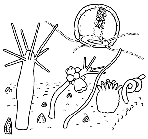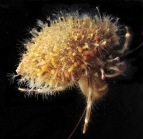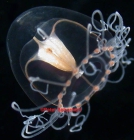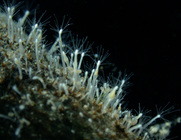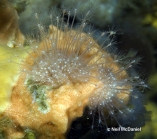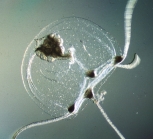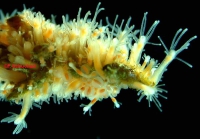
| Introduction | | Search taxa | | Taxon tree | | Taxon match | | Checklist | | Literature | | Stats | | Photogallery | | OBIS Vocab | | Log in |
WoRMS taxon detailsHydractiniidae L. Agassiz, 1862
1601 (urn:lsid:marinespecies.org:taxname:1601)
accepted
Family
Clavidae McCrady, 1859 · unaccepted > junior subjective synonym
Janariidae Stechow, 1921 · unaccepted > junior subjective synonym
marine, brackish,
recent + fossil
Agassiz, L. (1862). Contributions to the natural history of the United States of America. <em>Little Brown, Boston.</em> 4: 1-380, pls 1-19., available online at https://www.biodiversitylibrary.org/page/16068829
page(s): 339 [details]
Taxonomy Several genera of the Hydractiniidae have been redefined by Miglietta et al (2010, 2012) based on molecular phylogenies....
Taxonomy Several genera of the Hydractiniidae have been redefined by Miglietta et al (2010, 2012) based on molecular phylogenies. Many of these genera are now not diagnosable by morphological traits. Moreover, not all species were included in the phylogeny and thus for some Hydractinia species it is unclear to which genus they belong. If it is unclear to what genus a hydractiniid species belongs, then Hydractinia should be selected as default. More revisory work is clearly needed to obtain a stable system [details]
Schuchert, P.; Choong, H.; Galea, H.; Hoeksema, B.; Lindsay, D.; Manko, M.; Pica, D. (2025). World Hydrozoa Database. Hydractiniidae L. Agassiz, 1862. Accessed through: World Register of Marine Species at: https://www.marinespecies.org/aphia.php?p=taxdetails&id=1601 on 2025-07-01
Date action by 2004-12-21 15:54:05Z created db_admin
Nomenclatureoriginal description
Agassiz, L. (1862). Contributions to the natural history of the United States of America. <em>Little Brown, Boston.</em> 4: 1-380, pls 1-19., available online at https://www.biodiversitylibrary.org/page/16068829 page(s): 339 [details] original description (of Janariidae Stechow, 1921) Stechow E. (1921c). Neue Gruppen skelettbildender Hydrozoen und Verwandtschaftsbeziehungen rezenter und fossiler Formen. <em>Verhandlungen der deutschen zoologischen Gesellschaft.</em> 26: 29-31., available online at https://www.biodiversitylibrary.org/page/47281896 page(s): 30 [details] original description (of Clavidae McCrady, 1859) McCrady, J. 1859. Gymnopthalmata of Charleston Harbor. Proceedings of the Elliott Society of Natural History 1: 103-221, pls 8-12. , available online at https://www.biodiversitylibrary.org/page/42536587 page(s): 123 [details] basis of record Bouillon, J.; Boero, F. (2000). Synopsis of the families and genera of the Hydromedusae of the world, with a list of the worldwide species. <i>Thalassia Salent. 24</i>: 47-296 (look up in IMIS) [details] Taxonomyredescription
Schuchert, P. (2008). The European athecate hydroids and their medusae (Hydrozoa, Cnidaria): Filifera part 3. <em>Revue suisse de Zoologie.</em> 115: 221-302. page(s): 223 [details] Other Present Present  Inaccurate Inaccurate  Introduced: alien Introduced: alien  Containing type locality Containing type locality
From editor or global species database
Diagnosis Hydroids sessile, hydranths often polymorphic, usually epizootic; hydrorhiza either perisarc-covered stolonal tubes, or as an encrusting mat resulting from the coalescence of the stolonal system, either covered by a common layer of perisarc or with naked coenosarc; in some genera the hydrorhizal mat is reinforced by a calcareous skeleton; frequently with chitinous or calcareous spines forming sometimes pillars and branches, sometimes with protective tubes overarching the hydranths; gastrozooids either with one or several whorls of filiform tentacles beneath hypostome, or with scattered tentacles on the upper half of the body, exceptionally with one or two tentacles only; dactylozooids, when present, with no tentacles. Gonophores typically borne on gonozooids, these with one or more whorls of filiform tentacles or without tentacles and mouth (= blastostyles), giving rise to fixed sporosacs, eumedusoids, or free medusae.Medusa umbrella more or less bell-shaped, with or without slight apical process; manubrium tubular to sac-shaped, not extending beyond bell margin; with or without gastric peduncle; mouth with four simple or branched oral lips drawn out to form arms with terminal nematocyst clusters; four, eight, or more, solid, marginal tentacles, tentacles not in groups; four radial canals and circular canal; gonads on manubrium, interradial, sometimes extending along basal, perradial protrusions of the manubrium; with or without ocelli. [details] Taxonomy Several genera of the Hydractiniidae have been redefined by Miglietta et al (2010, 2012) based on molecular phylogenies. Many of these genera are now not diagnosable by morphological traits. Moreover, not all species were included in the phylogeny and thus for some Hydractinia species it is unclear to which genus they belong. If it is unclear to what genus a hydractiniid species belongs, then Hydractinia should be selected as default. More revisory work is clearly needed to obtain a stable system [details]
To Biological Information System for Marine Life (BISMaL) (from synonym Clavidae McCrady, 1859)
To Biological Information System for Marine Life (BISMaL) To European Nucleotide Archive, ENA (Clavidae) (from synonym Clavidae McCrady, 1859) To European Nucleotide Archive, ENA (Hydractiniidae) To Genbank To ITIS |
